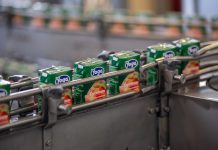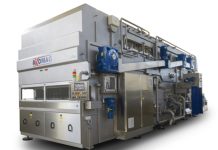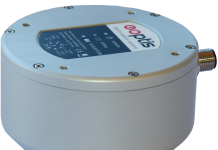 Level meters play a major role among the equipment used in industrial automation. In the food industry, there are many processing steps that require dosage and level controls, especially inside storage tanks.
Level meters play a major role among the equipment used in industrial automation. In the food industry, there are many processing steps that require dosage and level controls, especially inside storage tanks.
Accurate, continuous and reliable measurement of the level in storage tanks attached to production facilities is essential in the food industry. These controls ensure product quality and process efficiency. In fact, they allow a timely report on the quantity of raw material, semi-finished or finished product stored; improve production safety by protecting premises and equipment from unexpected product spills; prevent unwanted contamination between products, and even the dry operation of pumps.
They contribute to the business economy by limiting wastes, improving stock management, ensuring the reliability of weights and volumes in case of sales on account of processing. There are many different technologies for level control. The type of tanks installed in the facilities, and the physical state (liquid, solid or gaseous) of the substances stored are the first selection criteria; a further important factor is the easy integration into industrial automation systems. Level can be measured with spot measurements by means of level switches or continuously via level transmitters.
In the first case, a tank is equipped with a level switch that warns when the product level drops or exceeds a set height. Depending on requirements, the switch contact can be normally open or normally closed. The same tank may have a sender for continuous level measurement, providing fill data between 0 and 100%. The most complete instrument includes a probe, a transducer and an electronic circuit that transforms the signal generated by the transducer into a standard electric signal. The signal sent by the probe is proportional to the level reached by the product inside the tank.
Spot controls
Level switches can be capacitive, optical, conductive, vibration, fluctuating contact probes. The choice is based on the different operating principles and the product consistency of the product (liquid or solid) inside the storage tank. Generally, a system has three switches. The storage tank contains a minimum and a maximum level gauge. The main tank is equipped with one minimum-level meter. When the storage tank level drops below the set minimum, a PLC activates the pump that takes the product from the main tank to replenish the storage tank. The replenishment stops when the maximum level is reached. The minimum level sensor installed in the tank stops the pump if the product for the replenishment is finished.
Capacitive level switches generate an electric field and measure the change in the field when the product touches the sensor. They are small, accurate, reliable and relatively inexpensive instruments, with no moving parts. For the measurement, they must come into contact with the product which must not be moving. Optical level sensors convert light rays into electric signals. The measured amount of light is translated into the level measurement. They are relatively small, are not affected by high temperatures and pressures, and have no moving parts. Their lenses should be periodically cleaned to avoid measurement inaccuracies. Conductive level switches operate by applying an alternating current voltage to two electrodes.
When the Product touches them, the circuit closes, and the device measures the current generated. They are user-friendly, have no moving parts, and are relatively inexpensive; however, they require product contact and can only be used with liquids. Vibrating fork level switches consist of two parts that vibrate at a set resonance frequency. Contact between fork and product alters the frequency, and the device detects its presence. They can be used with liquids, powders, and fluids. In float level sensors, the liquid reaches the moving part, which closes or opens the contact. This system does not require a power supply to operate; however, it can be bulky, and moving parts can wear.
 Continuous measurement
Continuous measurement
The most popular continuous measurement techniques are based on pressure difference, ultrasound, guided wave radar, lasers, magnetic level indicators. The differential pressure system is used to measure the level of liquids in open, closed or pressurized tanks. The meter consists of a fixed structure, a thermometer, and a diaphragm with a sensor that measures the pressure of the liquid column inside the tank. The diaphragm is deflected by the pressure difference. When deflection changes the electrical properties of the sensor, an electrical signal is generated that is proportional to the deflection.
The strength of the signal depends on the density, pressure, height or level of the liquid inside the tank contents. In open tanks, the system calculates the difference between atmospheric pressure and fluid pressure. In closed tanks, the system calculates the difference between the pressure at the bottom of the tank, the pressure in the headspace of the tanks and the fluid pressure. The resulting value takes into account the thickness and temperature of the fluid. If the thickness of the fluid inside the tank is not homogeneous, multi-variable meters located at different tank heights are used, capable of compensating for thickness differences.
With the ultrasonic system, the level inside the tank is detected by means of sound waves. Pressure, temperature, and humidity change their speed. It is an indirect measurement system, with a degree of inaccuracy of less than 10 mm. It measures the distance between the transducer on the top of the tank and the product surface. It can be used in the presence of liquids, solids or heterogeneous mixtures, where a particulate solid phase is dissolved in a liquid dispersant phase and does not settle in a short time. Ultrasound is an acoustic vibration with frequencies above 20 thousand Hz; it is the conversion of electrical energy into mechanical energy.
The transmitter emits short ultrasonic pulses using the piezoelectric effect of a quartz crossed by an alternating electric current. The current causes the compression and expansion of this quartz. Alternate movements generate vibrations. In level measurement systems applied to tanks, the ultrasound bounces off the surface of the material and returns to the transducer. The parameter used to calculate the degree to which the tank is filled is the time elapsed between the emission of ultrasound and the capture of the return signal. This technique can also be used when the tank contains stirrers or electrical ballasts because the beam emitted by the transducer is relatively narrow and the above-mentioned obstacles do not interfere with the readout accuracy.
The devices are available two versions: an integrated version, where wave generator, sensor and electronics are in a single housing; and a remote version, where the two components are separated. The measurement is not affected by the chemical-physical characteristics of the product (composition, density, electrical conductivity or dielectric constant), but since ultrasound does not propagate in vacuum, this technology is not usable in vacuum or low-pressure tanks; when the product surface is uneven or skewed, the measurement accuracy decreases. Foam, steam, and condensation can influence the measurement.
The ultrasonic sensor is useful in presence of incompressible liquids or when high response speed is required. GUIDED WAVE RADARS (GWR) have a rod and probe in contact with the product. The rod serves as a guide for the electromagnetic wave that propagates along its linear or curved geometry. The radiation emitted is harmless to humans and the environment. The meter is mounted in the top of the tank and the probe reaches its bottom. With this technique, liquids with dielectric constants up to 1.8 and levels up to 60 meters can be measured. In the case of solid products, the measurement range is up to 125 meters.
The device transmits high frequency pulses into the probe and guides them through it. Pulses are reflected from the surface of the product, received by the data processing unit, and converted into level data. The parameter used to calculate the degree to which the tank is filled is the time between transmission and return signal capture. The reflective action depends on the dielectric constant of the liquid. Liquids with a high dielectric constant reflect the entire pulse, making the measurement reliable and accurate. This is the case with water or ammonia, for example. For liquids with low dielectric constant, the pulse reflection is weaker, but still evaluable using dedicated algorithms that allow to detect the level of liquefied gases, solvents, powders, polystyrene and other materials with low dielectric constant values.
This partial reflection allows, moreover, to measure, with a single instrument, the level of the interface between two liquids present inside the same tank having different dielectric constants. In the case of emulsions, the boundary between air and liquid is more blurred, but even in these cases the use of appropriate algorithms solves the problem. Measurement accuracy is not affected by process conditions such as density, viscosity, conductivity, coating, corrosivity, vapours, pressure and temperature variations; however, it is sensitive to deposits on the probe. Radar level probes are generally very accurate, in tax models, for instance, the accuracy of 0.5mm is achieved, while the process industry models provide accuracies of up to 5 mm. In the food industry, this technique is used to manage the supply of cereals, maize and flour or to automate packaging processes.
 Metal tanks do not create problems, plastic, glass-resin or glass tanks allow the level to be measured from the outside of the tank, without the need to drill it. In the case of flow calming pipes, the material of choice is steel. A plastic pipe would be crossed by the electromagnetic wave. The calming pipe interior must be smooth: Welds, holes or slotted holes that are not well finished can cause interference. Like the ultrasonic meter, the laser meter is mounted on top of the tank and faces downwards. Instead of emitting a sound wave, it emits a beam of light. The light reflected from the surface of the product inside the tank reaches the meter, where it is detected by an optical receiver.
Metal tanks do not create problems, plastic, glass-resin or glass tanks allow the level to be measured from the outside of the tank, without the need to drill it. In the case of flow calming pipes, the material of choice is steel. A plastic pipe would be crossed by the electromagnetic wave. The calming pipe interior must be smooth: Welds, holes or slotted holes that are not well finished can cause interference. Like the ultrasonic meter, the laser meter is mounted on top of the tank and faces downwards. Instead of emitting a sound wave, it emits a beam of light. The light reflected from the surface of the product inside the tank reaches the meter, where it is detected by an optical receiver.
The distance is calculated based on the time it takes the light to reach the surface of the product and return to the instrument. Compared to the sound pulse of an ultrasonic meter, the laser beam is much narrower. This allows level checking to be performed from locations that ensure consistent and reliable readings, even in tanks containing equipment such as stirrers or coils or in very narrow tanks. The laser emitter can be mounted on the tank cover or along the tank walls and is useful for measuring solids or liquids regardless. Magnetostrictive level transmitters are used to measure the level of liquids. They consist of three parts: Probe rod, circuit unit and magnetic float. They provide four data points: Level, interface, temperature and headspace.
They can be equipped with flexible or rigid probe. Multiple floaters can be included, enabling measurement of both the upper level and any interface between multiple liquids. The end of the probe is sealed, the rod is hollow to allow precision magnetostrictive wires to pass through. A sensor detects the temperature. The maximum probe length is 23 meters, while a flexible cable design is used beyond 6 meters of depth. The shell that contains the electronic part is made of aluminium alloy or stainless steel. It consists of a double chamber, where the transmission part is separated from the wiring part. A piezoelectric sensor, connected to one end of the magnetostrictive wire, sends ten pulses of current through the wire every second.
An annular magnetic field is generated that moves downwards until it interacts with the magnetic field of the floater. A torsional stress wave is generated that moves along the magnetostrictive line at a known velocity. The time interval between the initial pulse and the return of the torsional stress wave is evaluated by means of a timer circuit and allows the position of the float and consequently the liquid level to be determined. The probe can be inserted directly into the tank. In this case it is configured as a sight-glass but without allowing the liquid to be directly visible in the column or the probe may be placed outside, parallel to the tank.



